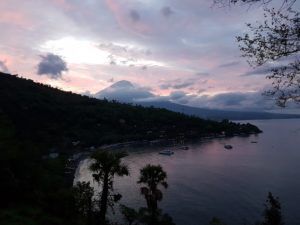A mass evacuation has been ordered from Vanuatu’s Ambae Island following a volcanic eruption.

GNS Science volcanologist Brad Scott is heading to Vanuatu on Friday to work with the local GeoHazards Group. He provided some background information on the Vanuatu, Bali and Mexico volcanoes that are currently active.
Brad Scott, volcanologist, GNS Science, comments:
“The Pacific Rim of Fire is always active, this could be volcanic activity or earthquake/Tsunami events.
“There will always be around 5-10 volcanoes active at any one time and may be another 5 or so showing signs of volcanic unrest (waking up).
“The volcano in Bali is waking up. It’s a volcano that hasn’t erupted for 50 years and is going through volcanic unrest as it wakes up. The locals have moved a lot of people as a precaution. Up there the population is so dense they end up living in places that shouldn’t be occupied, hence the need for evacuations when there is a problem and big numbers involved. The volcano is capable of significant local eruptions, should the unrest develop into an eruption.
“The volcano in Mexico is frequently active and the level of activity is now increasing. One could say that’s how this volcano works. Sometimes it’s quiet, other times it’s very active.
“In Vanuatu, there are many active volcanoes, some always in eruption, others rest and then erupt. Yasur has been in eruption since first spotted by Captain Cook in the 1770s. Similar for Ambrym, always active has summit lava lakes etc. Currently, it is more active.
“Ambae was last active in 2005/2006, a volcanic cone grew in one of the summit crater lakes and some of the local population were relocated on the island (not evacuated off the island). GNS provided aid and assessment at that time via MFAT.
“Currently, the volcano is having a very similar eruption, a cone is growing in the lake again. The Government is concerned and has started some evacuations.
“Lopevi volcano is also showing signs of waking up, lesser issues there as no residents on the island.
“In summary, volcanic activity is very common around the Pacific Rim, this is very much business as usual; that is some volcanoes waking up and creating issues for the local residents, meanwhile others are erupting, some weaker or stronger than normal…others wait their turn.”
The Australian Science Media Centre also gathered expert comments on the Bali volcano earlier this week.
Dr Bill McGuire is a Professor of Geophysical & Climate Hazards at the University College London
“Mount Agung is well known amongst volcanologists as a volcano capable of pretty hefty eruptions.
“The last major blast in 1963 not only took more than 1200 lives, but also had a measurable cooling impact on the global climate.
“With more than half a century on, this renewal of activity does not come as a surprise, and could end with a significant and potentially lethal eruption.”
Emeritus Professor Ray Cas is from Monash University and an expert in volcanoes
“Mt Agung volcano is a very large strato-volcano that is over 3000 m high and located in Northeast Bali. It experiences a major explosive eruption (> VEI 4) about once every century. The last eruption occurred in 1963-1964 with the death toll of about 1500.
“That eruption was multifaceted including the eruption of lavas, a large volume of widely dispersed volcanic ash, and the formation of fast flowing, hot, pyroclastic flows of ash, gas and rock debris, which killed the most people. In addition, because of the height and steep sides of the volcano, volcanic mudflows also formed causing significant loss of life.
“The current crisis of earthquakes under the volcano and increased gas release from the crater suggests to Indonesian volcanologists that an eruption is imminent. Many of the earthquakes are volcanic earthquakes related to the rise of molten rock or magma inside the volcano, and because these are becoming shallower Indonesian authorities consider the likelihood of an eruption occurring to be significant. This has led to the evacuation of the population within a 12 km radius of the volcano.
“It is not possible to predict exactly what the style of the eruption will be if it occurs, but if it is of the magnitude and the scope of the 1963-64 eruption, then this will be a major one with many primary and secondary volcanic hazards. Whether or not air traffic into Denpasar airport will be affected by an eruption of Agung volcano will depend on the wind direction at the time of the eruption, which controls the direction of dispersal of airborne ash.”